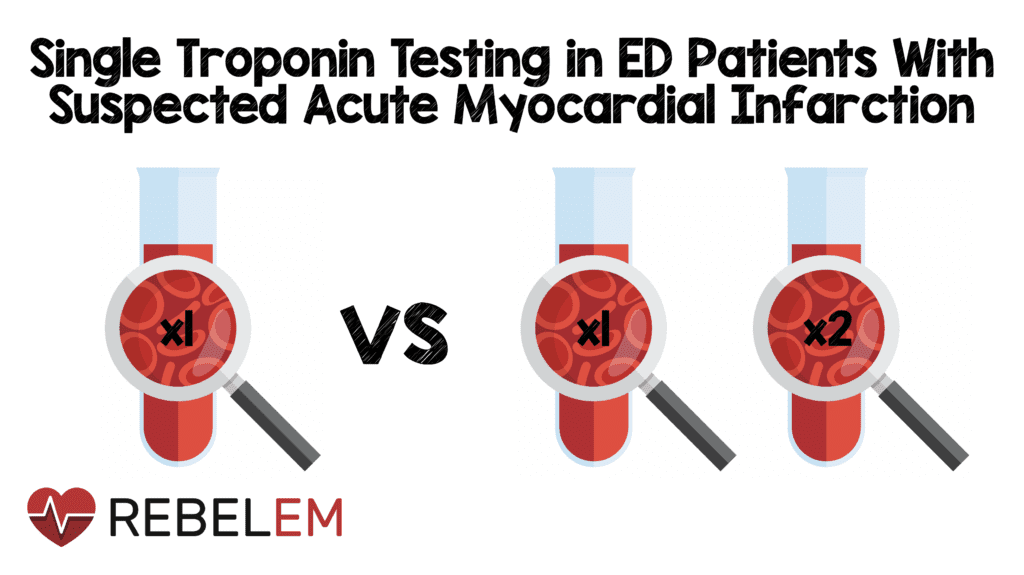
Recent studies using high sensitivity troponin (hsTnT) have shown that if the initial troponin is very low, one troponin may be sufficient to safely discharge patients from the ED, especially when combined with the HEART score. In practice however, in countries where hsTnT is not generally available, some clinicians have adopted this strategy using conventional troponin. This particular practice of using single conventional troponin testing has not been studied well.
Paper: Wassie et al. Single versus serial measurements of cardiac troponin in the evaluation of emergency department patients with suspected acute myocardial infarction. JAMA Network Open 2021. [Link is HERE]
Clinical Question: Do emergency department patients discharged after a single negative troponin test have similar outcomes to patients receiving multiple tests?
What They Did:
Design:
- A retrospective analysis of prospectively collected data
- 15 community EDs between January 1, 2015 to December 31, 2017 in Southern California
- All sites used the same conventional troponin-I (cTnI) assay (Access AccuTnI+3 assay from Beckman-Coulter, Brea, California)
HEART Score:
- The HEART score was calculated using clinical and demographic data. HEART (History, Electrocardiogram, Age, Risk factors, Troponin) is a 0- to 10-point scoring system initially developed and validated in The Netherlands, and after widespread worldwide validation currently recommended by the American Heart Association.
- The patients’ HEART-scores are categorized as low (0 to 3), moderate (4 to 6), and high risk (7 to 10) to aid clinical decision making
Troponin:
- Physician education was provided to encourage repeat troponin testing at least 3 hours after symptom onset or after the peak of symptom severity. Physicians were encouraged to use timing of symptoms, initial troponin value and initial HEART score to determine the benefit of repeat troponin testing and further clinical management
- Majority of the repeat tests were placed 3-6 hours after the first troponin was drawn
Inclusion:
- Adult ED patients with chest pain
- Member of Kaiser Permanente Southern California (KPSC) health plan
- Evaluation for suspected ACS with a HEART score
- Initial conventional troponin-I level below the limit of quantification (<0.02 for this assay)
Exclusion:
- Non-members of KPSC
- No continuous insurance coverage for one-year prior to ED visit
- Do-not-resuscitate (DNR) status
- Hospice status
- Initial troponin-I ≥ 0.02
Outcomes:
- Primary:
- 30-day MI or cardiac mortality after ED discharge
- Secondary:
- Unstable angina
- Invasive coronary angiography
- Percutaneous transluminal coronary angioplasty (PTCA)
- Coronary artery bypass graft (CABG)
Results:
- 27,918 patients included in the final analysis
- 14,459 patients (51.8%) with a single troponin order
- Patients were younger and less likely to have comorbid conditions including hypertension, diabetes, lipid disorder, renal failure and congestive heart failure.
- Patients generally had a lower HEART score
- 13,459 patients (48.2%) with serial troponin orders
- Only 66 (0.5%) had subsequent positive troponin
- 10,611 (38.0%) had two troponin measurements
- 2,848 (10.2%) had ≥ 3 serial measurements
- 14,459 patients (51.8%) with a single troponin order
- 30d MI or Cardiac Mortality after ED Discharge (Primary Outcome):
- Single troponin group: 0.4%
- Serial troponin group: 0.4%
- Adjusted odds ratio 1.41; 95% confidence interval (0.96-2.07)
- 30-day acute myocardial infarction: OR 1.28, CI 0.85-1.92
- 30-day cardiac mortality: OR 3.02, CI 0.97-12.08
-
- Single Troponin: 0.07%
- Serial Troponin: 0.02%
- Absolute Difference 0.05%
-
- Secondary Outcomes:
- CABG: OR 0.24, 95% CI: 0.11-0.48
- Invasive coronary angiogram: OR 0.46, 95% CI: 0.38-0.56
- PCI: OR 0.73 95% CI: 0.44-1.18
- Unstable angina: OR 1.05 95% CI: 0.76-1.44
Strengths:
- A large population-based study that reflects the practice pattern in multiple community-based EDs across Southern California
- The study population is diverse
- This study is performed with the conventional troponin assay which is currently widely used in the US
- Follow-up information is available for all the patients
Limitations:
- Diagnosis of MI made by EMR diagnosis and not adjudicated
- Given the observational study design, causality cannot be assumed
- Residual confounding may be present despite adjustments of multiple variables
- The dataset used in this analysis lack the details available in trials and registries, particularly they cannot assess the timing of symptom onset which may be the key variable in determining which patients benefit most from serial testing
- Specific data on the HEART score versus outcome per participant are not reported
Discussion:
- Currently, the AHA and ESC both recommend serial cardiac troponins to identify and exclude MI. This is due to the potential slow rise and the late peak of troponin (2 to 4hrs and 8 to 12hrs respectively). Most patients presenting to the ED with chest pain are low risk for ACS and/or have had prolonged symptoms and may not benefit from repeat troponin testing despite these guideline recommendations
- Wassie et al. demonstrate that in clinical practice the single troponin strategy is safe when performed along with a clinician’s clinical assessment and risk stratification by the HEART score
- Cardiac mortality was slightly higher in the single troponin group compared to serial troponin group (0.02% vs 0.07%); however, this was not statistically significant, and a 0.05% difference falls well below a 1% threshold
- Given the lower performance of the conventional troponin assay, supplementation with risk stratification tools such as the HEART and EDAC scores may improve the accuracy of use of single troponin for a rule-out
- The study also demonstrates that physicians are able to appropriately identify patients at higher risk based on other clinical factors beyond a 2nd troponin test
- Over 50% of physicians in this large study are already using a low-risk HEART score and a single troponin test before discharging patients with chest pain home. This implies that 50% of physicians are already only getting a single contemporary troponin test and of note only 66 patients (0.5%) with serial troponin testing had a subsequent positive troponin test which again is still below the 1% acceptable threshold
- The ability to effectively and promptly rule out AMI using single troponin can reduce the need to keep patients in the ED for serial troponin testing
- Strategies allowing rapid and accurate discharge of low-risk patients after a single troponin order can significantly reduce healthcare costs, and potentially reduce overcrowding and increased ED length of stay
- This approach can improve patient experience by decreasing length of stay in ED and help to relieve ED overcrowding while maintaining safety
- Patients discharged after a single troponin had a lower rate of CABG, and invasive coronary angiogram within 30 days
- When compared to conventional troponin, the hsTnI has higher sensitivity with a more pronounced difference in performance for patients presenting with recent-onset chest pain as well as those with low to moderate risk
- As shown in this study, physicians are currently already applying a single troponin strategy and it appears to be as accurate and safe as a serial troponin diagnostic approach for a selected group of patients
Author Conclusion: “When compared to serial troponin testing, discharge after a single negative conventional troponin is routinely done among ED patients, and appears safe based on current physician decision-making with no difference in rates of 30-day cardiac mortality and AMI.”
Clinical Take Home Point: Discharging patients presenting to the ED with chest pain after a single negative conventional troponin and proper risk stratification with the HEART score can be considered to be as safe as serial troponin testing while being less time consuming, less costly and therefore more patient oriented.
References:
- Wassie et al. Single versus serial measurements of cardiac troponin in the evaluation of emergency department patients with suspected acute myocardial infarction. JAMA Network Open 2021. [Link is HERE]
- Backus BE et al. Troponin Testing in the Emergency Department – When 2 Become 1. JAMA Network Open 2021. [Link is HERE]
Post Peer Reviewed By: Salim R. Rezaie, MD (Twitter: @srrezaie)



